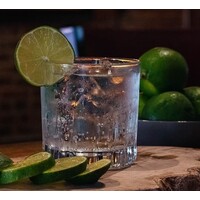How To Use Botanicals & Gin Making

Learn how to use fresh Botanicals to take your Gin making to another level .
Two Easy Ways to Make Gin With Botanicals
The history of gin
Gin dates back centuries and although the Dutch physician and scientist Franciscus Sylvius is often believed to have discovered it in the 17th century, there are references to gin (or genever as it was also known) as far back as the 13th century. Its popularity boomed in England aided by the fact that gin production did not require a licence. ‘Mothers ruin’ as it was sometimes called, was blamed for all sorts of public misconduct and drunkenness! Today, its reputation is much less sullied, and gin is the spirit of choice for many.
Over the past few years, the craft gin market has boomed. Gin consumption has increased more than any other spirit in Australia, up from 0.5% in 2018 to 8% in 2019. Boutique gin distilleries are popping up everywhere and home-distillers are living their best lives crafting their own signature gin batches with some amazing Aussie botanicals. And we know why. Gin is such a versatile spirit; you can explore so many different flavour profiles and it’s easy to make great gin!
What is gin?
There are two essential components to gin: the botanicals and the neutral spirit. The main botanical is the juniper berry which gives gin its distinct aroma and flavour and by law, gin must contain at least 40-50% juniper berries in the total weight of the botanicals to be called a gin.
Botanicals
Although juniper berries look like blueberries, they are more closely related to the pinecone than a berry. Their flavours vary depending on the soil and climate of where they are grown which is why gins with similar botanicals added can taste quite different. Juniper adds an astringent pinelike flavour profile.
Coriander is the second most used botanical in gin after juniper. It lends a lemony-citrus note with a slightly nutty, spicey profile adding more body to the spirit.
If you’re wanting to brew your own gin, we recommend starting with 50% juniper, 30% coriander, and the remaining 20% botanicals of your choosing. This is the fun bit! Creating different flavour combinations to produce unique signature gins is something we love to experiment with.
Less is often more with many gin botanicals. For example, when used in higher volumes, citrus peel may lead to haziness in your spirit due to the oils extracted not being soluble in water, so once you dilute your spirit down to drinking ABV, you may notice some cloudiness.
There are some excellent online resources to help you choose your botanicals including this guide on our website.
At AHB, our range of quality botanicals will get you successfully distilling in no time.
How to Make Gin
There are two popular methods used to infuse the flavours of the botanicals into the neutral alcohol to make gin and they are ‘steeping’ and ‘vapour infusion’. Crushing and/or leaving the botanicals whole - will also impact the flavour extraction.
Steeping
Using the steeping method, the neutral filtered spirit is placed in a glass vessel with the botanicals and steeped for until the desired flavour is attained. Alternatively, you can steep each botanical individually and then combine to achieve the flavour profiles you desire.
NOTE - The final gin product will carry a moderate to deep hue from the steeping of the juniper berries.
Vapour infusion
Here, the botanicals never make contact with the neutral spirit. The botanicals are placed in a basket above the spirit and when the still is heated up, the alcohol vapour passes through the botanicals extracting flavours - crushing the botanticals will also vary the flavour extraction. The infused vapour is cooled and condenses into a liquid which is then reduced to bottling strength. The result is a gin with a mellower botanical flavour. The Still Spirits gin botanical basket can be used with either the Turbo 500 distilling system or the Alembic Pot still.
This method is essentially the same with both stills but the Alembic Still with a complete copper surface area is designed to further intensify the botanical flavours.
The Basic steps are -
1) Run the still ( Alembic or T500 ) as normal by distilling your wash then filtering your spirit. This is known as the stripping run.
2) Attach the botanical basket filled with botanicals onto the base of the condenser for the second distillation which is your botanical run for vapour infused botanical gin.
For those using a Turbo 500 still, it is worth noting that as it’s a reflux still, the condenser will naturally remove all flavours from the alcohol wash to produce a polished neutral spirit. To infuse the botanicals a few adjustments, need to be made to the condenser:
Unscrew the T500 column from the boiler lid and remove all the saddles from the condenser. (Please note you need to set up your column as per the Water Distillation Assembly as per the instructions on Page 9 of the Turbo 500 instruction manual.)
For more detailed instructions read our Guide on ‘How to make Gin from Botanicals using a Turbo 500’.
If you’re not quite sure what flavours and aromas you like and don’t want to make big batches to trial, using a still like the Air Still is a great option for experimenting with smaller vapour distillation batches. You can also try steeping your botanicals in jars of neutral spirit to see what profiles you enjoy.
For a single vapour infusion batch using the Air Still, a great starting point is this basic London Dry recipe. You can make changes to this and experiment with other botanicals if you’d like to try a different style but stick to around 30g of total botanicals. To make gin from botanicals using the Air Still you will need the Air Still Botanical Basket.
Gin is one of our favourite spirits to make; very rewarding and who doesn’t like a G&T at the end of the day! As always, reach out if you have any questions, we’re happy to provide advice and help.
Cheers
Hamish and the Australian Home Brewing team
